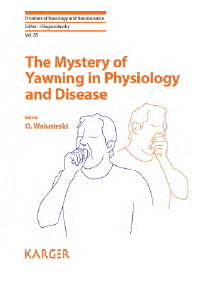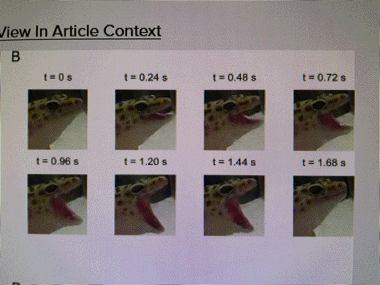

|
- mise à jour
du
- 10 avril
2025
- Zoolog Sci.
- 2025;42(1)
|
- Yawning
and Its Temperature-Dependent Modulation in
Leopard Geckos
- Kotake KT, Yamaguchi ST, Mukai Y, Zhou Z,
Norimoto H.
|

|
-
- Yawning is a stereotyped behavior
characterized by the involuntary and forceful
opening of the mouth during inhala- tion, a peak
in temporary muscle contraction, and the pas-
sive closure of the jaw during exhalation
(Barbizet, 1958; Provine, 1986). Previous
studies have indicated a circadian rhythm in
yawning for humans and primates (Deputte, 1994;
Baenninger et al., 1996; Zilli et al., 2008),
and that yawning stimulates behavioral arousal
in primates (Vick and Paukner, 2010).
- The frequency of yawning is influenced by
ambient temperature in endothermic animals. In
birds, yawning fre- quency peaked around
30°C during the increasing tempera- ture
condition and began to decrease as the
temperature rose further (Gallup et al., 2009).
Similarly, in humans, yawn- ing frequency
reached its highest around 20°C and
decreased as temperatures rose beyond or fell
below this point (Massen et al., 2014). These
findings suggest that yawning may play a role in
regulating body and brain tem- perature (Gallup
et al., 2016; Massen et al., 2021).
-
- Yawning is also observed in ectothermic
animals (Bakkegard, 2017; Yamada and Wada,
2023). Reports of increased locomotor activity
following spontaneous yawning in amphibians and
fish suggest that some functions related to the
behavior are conserved across vertebrates, such
as induction of behavioral arousal (Bakkegard,
2017; Yamada and Wada, 2023). However, the
relationship between tem- perature and yawning
in ectothermic animals remains unclear.
Specifically, it is unclear whether ambient
tempera- ture influences yawning frequency and
yawning-induced changes of activity levels in
ectothermic animals.
- Here, we observed yawning behavior and
associated changes in activity levels in the
leopard gecko, Eublepharis macularius, an
ectothermic reptile, in which the detection of
yawning behavior is highly straightforward,
under various temperature conditions.
-
 - Discussion
- We have demonstrated here that ambient
temperature affects yawning in leopard geckos. A
higher frequency of yawning was observed at
30°C than at 25°C (Fig. 2A). This
result is consistent with previous findings that
yawning fre- quency depends on ambient
temperature in humans and birds (Gallup et al.,
2009; Massen et al., 2014). It has been shown in
humans that yawning occurrence is temperature-
dependent, and yawning occurs most frequently
within an optimal temperature range (Massen et
al., 2014). Since our experiments were conducted
within the temperature range that geckos could
experience in their natural environment
(22&endash;24°C in March to
40&endash;45°C in June&endash;July) to
minimize stress, yawning might decrease at
temperatures below 20°C and above
40°C, which were not investigated in this
study.
-
- Additionally, with the increase in ambient
temperature, a significant decrease in yawning
duration was observed (Fig. 2B). While
interspecies comparisons of yawning duration
were conducted among some mammals and birds in a
previ- ous report (Massen et al., 2021), our
experiment is the first to examine the length of
yawning in the same individual under different
temperature conditions. Furthermore, we observed
a concurrent increase in movement speed as
ambient temperature rose (Fig. 2D). This feature
is consistent with findings from previous
research on rattlesnakes, which dem- onstrated a
positive correlation between temperature and
both the attacking speed and the gaping velocity
during strikes (Whitford et al., 2020).
Considering these findings, it is plausible that
the increase in ambient temperature not only
boosts overall activity speed but also
accelerates the movement of muscles around the
mouth. This could poten- tially contribute to
both the shorter durations of yawnings and
quicker mouth openings during attacks.
-
- Increase in locomotor activity after yawning
was observed at 30°C and 35°C (Fig.
3). This trend is similar to observations in
primates and consistent with the arousal- state
change hypothesis (Vick and Paukner, 2010).
Further- more, distinct periods conducive to
yawning were identified in geckos (Fig. 4A, B).
Interestingly, yawning exhibited a uni- modal
peak every 24 hour, while activity levels showed
bimodal peaks per day (Fig. 4C, D). This
suggests that yawning is not simply correlated
with changes in activity lev- els but also may
be influenced by other factors, similar to the
findings in humans and primates (Baenninger et
al., 1996). Further experiments under constant
conditions are needed to investigate whether
these patterns reflect the internal cir- cadian
clock or sleepiness, or are influenced by
external cues.
-
- In summary, we have demonstrated
temperature- dependent modulation of yawning in
leopard geckos. In par- ticular, we found that
yawning at 30°C and 35°C resulted in
an increase in post-yawning locomotor activity.
These results suggest that yawning may promote
behavioral arousal at temperatures of 30°C
and above. Moreover, we observed specific daily
periods during which yawning frequently
occurred. These characteristics align with
findings from previous research on endothermic
animals.
-
- However, it is possible that yawning in
geckos may exhibit features and functions not
previously reported in mammals. For example,
47.7% of the yawns observed in this study were
accompanied by tongue-flicking behavior (see
Supplementary Movie S2) within 30 seconds before
or after. Given that some of this behavior is
known to be a means of reptilian chemical
cognition (Graves and Duvall, 1983; Barbour and
Clark, 2012), it raises the possibility that
this type of yawning in geckos may also serve a
function in chemical cognition. This insight
suggests that the yawning behavior observed may
not merely be an arousal mecha- nism but could
also play a role in the animal's sensory inter-
action with its environment. Further studies are
now required to unveil conserved and
species-specific functions of yawn- ing,
contributing to their adaptation to varying
environments.
-
|
|



